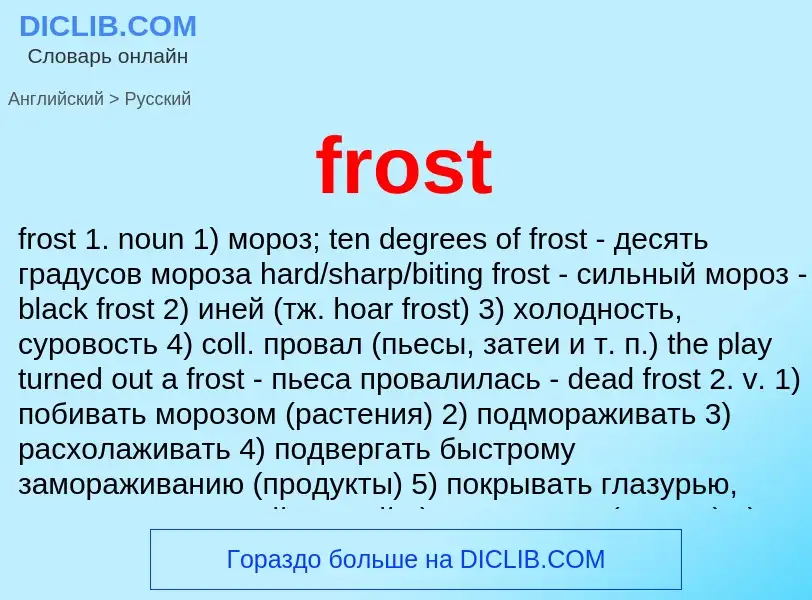Перевод и анализ слов искусственным интеллектом
На этой странице Вы можете получить подробный анализ слова или словосочетания, произведенный с помощью лучшей на сегодняшний день технологии искусственного интеллекта:
- как употребляется слово
- частота употребления
- используется оно чаще в устной или письменной речи
- варианты перевода слова
- примеры употребления (несколько фраз с переводом)
- этимология
hoar frost - перевод на Английский
Определение
---
(Frost) Роберт (1874-1963) , американский поэт. Стихи о ломке некогда цельного сельского мира, о нравственном кризисе современной цивилизации, трагической утрате живого, гармонического контакта между человеком и природой, а также о беспредельном многообразии и конкретике жизни (сборник "К северу от Бостона", 1914; "Нью-Гэмпшир", 1923; "Неоглядная даль", 1936; "Дерево-свидетель", 1942; "На вырубке", 1962). Глубоко народная лирика Фроста - в русле англоязычной классики и фольклора.
Википедия

Frost is a thin layer of ice on a solid surface, which forms from water vapor in an above-freezing atmosphere coming in contact with a solid surface whose temperature is below freezing, and resulting in a phase change from water vapor (a gas) to ice (a solid) as the water vapor reaches the freezing point. In temperate climates, it most commonly appears on surfaces near the ground as fragile white crystals; in cold climates, it occurs in a greater variety of forms. The propagation of crystal formation occurs by the process of nucleation.
The ice crystals of frost form as the result of fractal process development. The depth of frost crystals varies depending on the amount of time they have been accumulating, and the concentration of the water vapor (humidity). Frost crystals may be invisible (black), clear (translucent), or white; if a mass of frost crystals scatters light in all directions, the coating of frost appears white.
Types of frost include crystalline frost (hoar frost or radiation frost) from deposition of water vapor from air of low humidity, white frost in humid conditions, window frost on glass surfaces, advection frost from cold wind over cold surfaces, black frost without visible ice at low temperatures and very low humidity, and rime under supercooled wet conditions.
Plants that have evolved in warmer climates suffer damage when the temperature falls low enough to freeze the water in the cells that make up the plant tissue. The tissue damage resulting from this process is known as "frost damage". Farmers in those regions where frost damage has been known to affect their crops often invest in substantial means to protect their crops from such damage.


![[[Curitiba]] ([[Southern Brazil]]) is the coldest of [[Brazil]]'s [[state capital]]s; the [[greenhouse]] of the [[Botanical Garden of Curitiba]] protects sensitive plants. [[Curitiba]] ([[Southern Brazil]]) is the coldest of [[Brazil]]'s [[state capital]]s; the [[greenhouse]] of the [[Botanical Garden of Curitiba]] protects sensitive plants.](https://commons.wikimedia.org/wiki/Special:FilePath/CuritibaFrostGeada.jpg?width=200)


![A [[spider web]] covered in air hoar frost A [[spider web]] covered in air hoar frost](https://commons.wikimedia.org/wiki/Special:FilePath/Frostweb.jpg?width=200)
 (cropped).jpg?width=200)

![scanning electron]] (right) [[microscopy]] scanning electron]] (right) [[microscopy]]](https://commons.wikimedia.org/wiki/Special:FilePath/LightLTSEM.jpg?width=200)
![highest town in Venezuela]], [[Apartaderos]]: Because of its location in an [[alpine tundra]] [[ecosystem]] called ''[[páramo]]'', a daily freeze-and-thaw cycle, sometimes described as "summer every day and winter every night", exists. highest town in Venezuela]], [[Apartaderos]]: Because of its location in an [[alpine tundra]] [[ecosystem]] called ''[[páramo]]'', a daily freeze-and-thaw cycle, sometimes described as "summer every day and winter every night", exists.](https://commons.wikimedia.org/wiki/Special:FilePath/Nevada-Apartadero-Merida-Venezuela.jpg?width=200)

![Dead plant leaves during [[Winter Storm Uri]] in a backyard in [[Northern Mexico]], with below freezing temperatures. Dead plant leaves during [[Winter Storm Uri]] in a backyard in [[Northern Mexico]], with below freezing temperatures.](https://commons.wikimedia.org/wiki/Special:FilePath/Plants affected by Below Freezing Temps.jpg?width=200)
![[[Roses]] with protection against frost - [[Volksgarten, Vienna]] [[Roses]] with protection against frost - [[Volksgarten, Vienna]]](https://commons.wikimedia.org/wiki/Special:FilePath/Winterschutz.jpg?width=200)









![Hausdülmen]], [[North Rhine-Westphalia]], Germany Hausdülmen]], [[North Rhine-Westphalia]], Germany](https://commons.wikimedia.org/wiki/Special:FilePath/Dülmen, Hausdülmen, Distel -- 2021 -- 5079.jpg?width=200)

![Frost on plant leaves in the [[Himalayas]] Frost on plant leaves in the [[Himalayas]]](https://commons.wikimedia.org/wiki/Special:FilePath/Frost on leaves.jpg?width=200)
![Hoar frost in [[Julian Alps]] Hoar frost in [[Julian Alps]]](https://commons.wikimedia.org/wiki/Special:FilePath/Hoar frost on a snow field.jpg?width=200)
![Frost on birch tree in [[Stockholm]] Frost on birch tree in [[Stockholm]]](https://commons.wikimedia.org/wiki/Special:FilePath/Frost on Birch Tree in Stockholm 20180110.jpg?width=200)
![Frost on grass in Ranu Pani, [[East Java]], Indonesia Frost on grass in Ranu Pani, [[East Java]], Indonesia](https://commons.wikimedia.org/wiki/Special:FilePath/Frost in Ranu Pani on 4 August 2018 by Susanto Tan 6.jpg?width=200)
![Frost on birch stem in [[Norway]] Frost on birch stem in [[Norway]]](https://commons.wikimedia.org/wiki/Special:FilePath/Frost on birch tree.jpg?width=200)
![Frost on grass in [[Sydney]] Frost on grass in [[Sydney]]](https://commons.wikimedia.org/wiki/Special:FilePath/Sydneyfrost.jpg?width=200)
![An oak leaf with frost in [[Sweden]] An oak leaf with frost in [[Sweden]]](https://commons.wikimedia.org/wiki/Special:FilePath/Leaf with frost.jpg?width=200)
